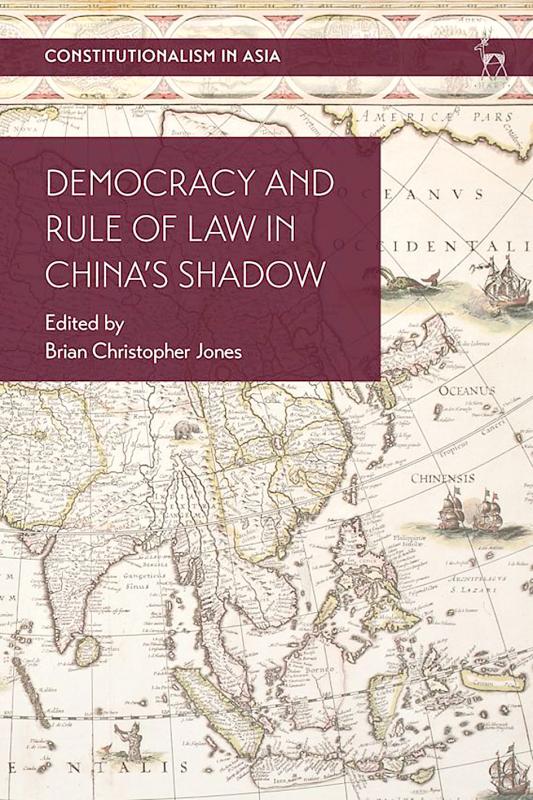For those countries and states unfortunate enough to lie within China’s penumbral fringes, “the space within which democracy and the rule of law operate is fraught with tensions.”
This observation from Amy Barrow’s conclusion to this fine collection summarizes the unifying preoccupation of the book’s 11 chapters. Whether the topic is Taiwan’s same-sex marriage controversy, communitarianism in Singapore or the UN’s failure to develop a human right to democracy, China — as the title suggests — is always an ominous presence.
Readers familiar with the previous collection edited by Brian Christopher Jones — Law and Politics of the Taiwan Sunflower and Hong Kong Umbrella Movements (2017) — can expect analysis of a similar quality here. Indeed, as it covers those movements, this book can be seen as, if not a sequel, then a partner volume to the earlier work.

A word on the text: The collection is published by Bloomsbury subsidiary Hart Publishing in conjunction with National University of Singapore, and the house style appears to be British English. The problem is, it’s hard to tell in places, with American spellings frequently appearing.
There are other inconsistencies, typos and odd choices including Democratic Progressive Party (DPP) abbreviated as DDP — in one instance the two appear in the same sentence — and the use of “Administrative Yuan” instead of “Executive Yuan” for Taiwan’s Cabinet. While errors can inevitably creep into a dense academic work such as this, the text certainly would have benefited from some fine-tuning.
The book is divided into three parts, each examining challenges to democracy and the rule of law. The first focuses on the limits of civil disobedience mainly in relation to the 2014 Sunflower Movement in Taiwan and the Occupy Central campaign and subsequent Umbrella Movement in Hong Kong the same year.
In the opening chapter, authors Fu Hualing (傅華伶) and Michael Jackson examine public assembly and protest laws in China, Taiwan and Hong Kong. There is a surprising revelation concerning the minimum number of participants required for a protest to be deemed illegal in the various jurisdictions: In Hong Kong, the figure is 30, in Taiwan only three; in China, no number is specified.
“Protest abounds in China,” Fu and Jackson observe — again, somewhat surprisingly. However, the point here is that legal rights to protest are recognized “on the condition that the claim-making and rights asserting process is neither organized nor does it appear in a collective form.” The import is clear: Protests of any size are suspect in China precisely because of their potential for fostering collective action.
The authors next turn their attention to evolution of protest movements in Taiwan which are described as “a textbook example of political transition, democratic resilience and historical legacy.”
Critiquing the Assembly and Parade Law (集會遊行法) of 1992, Fu and Jackson note the irony of its roots in Martial Law-era provisions. The authors take us through a series of tweaks to the law, including a 1998 Judicial Yuan interpretation invalidating police powers to deny applications on grounds of national security, a stipulation that “commonly appears in protest laws elsewhere.”
Although the courts struck down an attempted review to allow demonstrations without prior application during the Sunflower protests, overall, the judiciary in Taiwan is shown as safeguarding “the exercise of constitutional rights so citizens can participate in protest ‘without fear.’”
Taiwan’s courts showed similar restraint and flexibility in their handling of cases brought against the Sunflower protestors, conclude Jimmy Chia-Hsin Hsu (許家馨) and Anne SY Cheung (張善喻) in chapter two.
Through the lens of three models of law — repressive, autonomous and responsive — the authors compare the relatively lenient and creative responses of the judges in Taiwan to the more heavy-handed but ostensibly by-the-book approach of the Hong Kong judiciary.
Further drawing on the civil disobedience thresholds established by jurisprudence philosophers such as John Rawls and Ronald Dworkin, the chapter concludes that, despite the Hong Kong judges’ efforts “to be apolitical in the autonomous law model” they applied legal conventions selectively to “maintain institutional integrity.”
In contrast, the Taiwanese courts “wavered” between autonomous and responsive law in their adjudicating. The former refers to a system where law is not only independent but also intrinsically inhibitive of political abuses of power; while the latter “seeks not only to adjudicate but regulate society by responding to social needs and aspirations.”
What comes across through this and subsequent chapters — most notably the laudably balanced appraisal of China’s rule of law by Zhai Xiaobo (翟小波) — is that such “procedural” (as opposed to substantive) applications of law clearly don’t prevent government manipulation and, ultimately, rampant abuse and repression.
Rounding out the opening segment, chapter three provides a fascinating look at oath taking controversies in Hong Kong and Taiwan. Comparisons are made with the refusal of legislators from the Irish Republican party Sinn Fein to take the parliamentary oath in the UK.
While the oath taking dispute died down in Taiwan with the end of authoritarianism, it remains relevant. As recently as June, DPP Legislator Tsai Yi-yu (蔡易餘) called for an end to a provision that means oaths must be sworn in front of Sun Yat-sen’s (孫中山) portrait.
In part two, conflicts between democracy and the rule of law are examined. National Taipei University law professor Kuan Hsiao-wei’s (官曉薇) analysis of the religious right’s attempt to scupper same-sex marriage is thorough and compelling.
Although ultimately unsuccessful, thanks to the decision to abide by the constitution, the efforts of groups such as absurdly named Coalition for the Happiness of Our Next Generation should sound an alarm, writes Kuan. Balancing Taiwan’s “dynamic democratic impulse with the rule of law” to ensure “important minority rights remain protected and valued by the citizenry” will be key going forward.
The final portion of the book makes the effect of China’s shadow more explicit. Tying into the chapter on oath-swearing, Lin Chien-chih’s (林建志) essay makes the case that the Constitution of the Republic of China (ROC) “entrenches several undemocratic elements which prolong the ideology of the self-deceiving one China-policy.”
For this reason, concludes Lin, an associate research professor with Academia Sinica, “the domestication and indigenization” of the ROC constitution through amendment has failed. Worse: these amendments “not only obstruct future constitutional revision but also etch the one-China policy into the supreme law.”
Social movements and judicial review, Lin contend, do not change the “undemocratic nature” of the constitution and, as a result, referendum and decentralized political participation are recommended.
Mention should also be made of Hong Kong activist and legal scholar Benny YT Tai’s (戴耀廷) excellent chapter on authoritarian creep in the Special Administrative Region. Tai painstakingly dissects Beijing’s specious interpretations of and changes to the Basic Law to strangle dissent and democracy.
As the “frontline battle” between authoritarianism and freedom, Hong Kong could, Tai predicts, become a litmus test for the rest of the world. When considered in conjunction with, in Barrows’ words, “the draconian responses to the COVID-19 pandemic” adopted by even liberal democracies, the findings in this collection are sobering.

As I finally slid into the warm embrace of the hot, clifftop pool, it was a serene moment of reflection. The sound of the river reflected off the cave walls, the white of our camping lights reflected off the dark, shimmering surface of the water, and I reflected on how fortunate I was to be here. After all, the beautiful walk through narrow canyons that had brought us here had been inaccessible for five years — and will be again soon. The day had started at the Huisun Forest Area (惠蓀林場), at the end of Nantou County Route 80, north and east

Exceptions to the rule are sometimes revealing. For a brief few years, there was an emerging ideological split between the Democratic Progressive Party (DPP) and Chinese Nationalist Party (KMT) that appeared to be pushing the DPP in a direction that would be considered more liberal, and the KMT more conservative. In the previous column, “The KMT-DPP’s bureaucrat-led developmental state” (Dec. 11, page 12), we examined how Taiwan’s democratic system developed, and how both the two main parties largely accepted a similar consensus on how Taiwan should be run domestically and did not split along the left-right lines more familiar in

Specialty sandwiches loaded with the contents of an entire charcuterie board, overflowing with sauces, creams and all manner of creative add-ons, is perhaps one of the biggest global food trends of this year. From London to New York, lines form down the block for mortadella, burrata, pistachio and more stuffed between slices of fresh sourdough, rye or focaccia. To try the trend in Taipei, Munchies Mafia is for sure the spot — could this be the best sandwich in town? Carlos from Spain and Sergio from Mexico opened this spot just seven months ago. The two met working in the

This month the government ordered a one-year block of Xiaohongshu (小紅書) or Rednote, a Chinese social media platform with more than 3 million users in Taiwan. The government pointed to widespread fraud activity on the platform, along with cybersecurity failures. Officials said that they had reached out to the company and asked it to change. However, they received no response. The pro-China parties, the Chinese Nationalist Party (KMT) and Taiwan People’s Party (TPP), immediately swung into action, denouncing the ban as an attack on free speech. This “free speech” claim was then echoed by the People’s Republic of China (PRC),